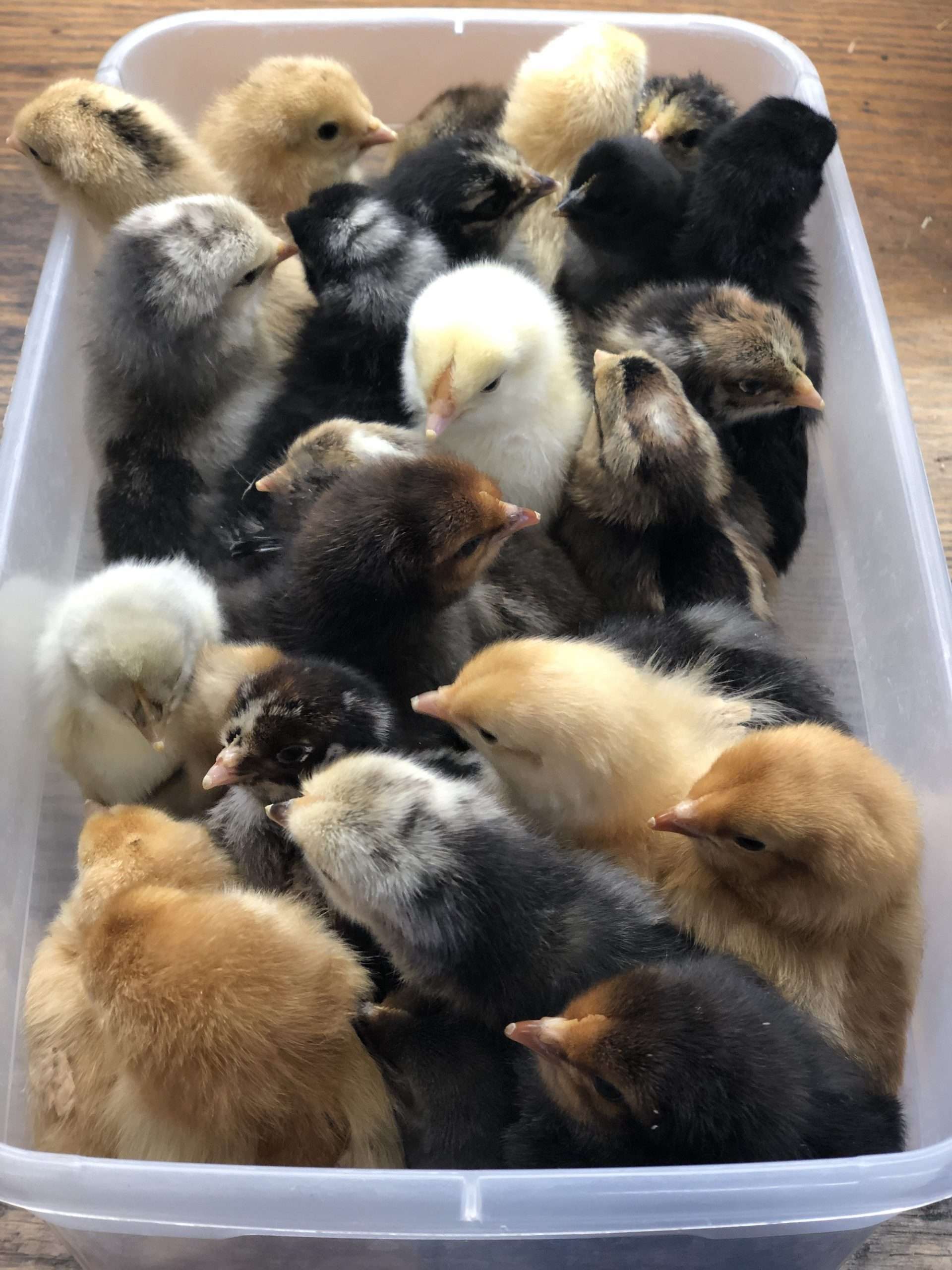You’ve decided to hatch your own chickens, but there are hundreds of egg incubators to choose from. How do you pick the best one for you?!
I’ve been hatching chicken eggs for years and have used several different incubators along the way. I’ve had great successes and failures, both of which I’ve learned a lot from.
Choosing the best egg incubator for you is a make or break decision. When it comes to incubators, you really do get what you pay for. However, that doesn’t mean you need to go buy a professional-grade incubator for $3,000.
In this comprehensive article, I break down 8 of the best egg incubators in 2024 for backyard or homestead chicken keepers. I’ll also provide direct links to the product so that you don’t have to go searching around!
Let’s jump in!
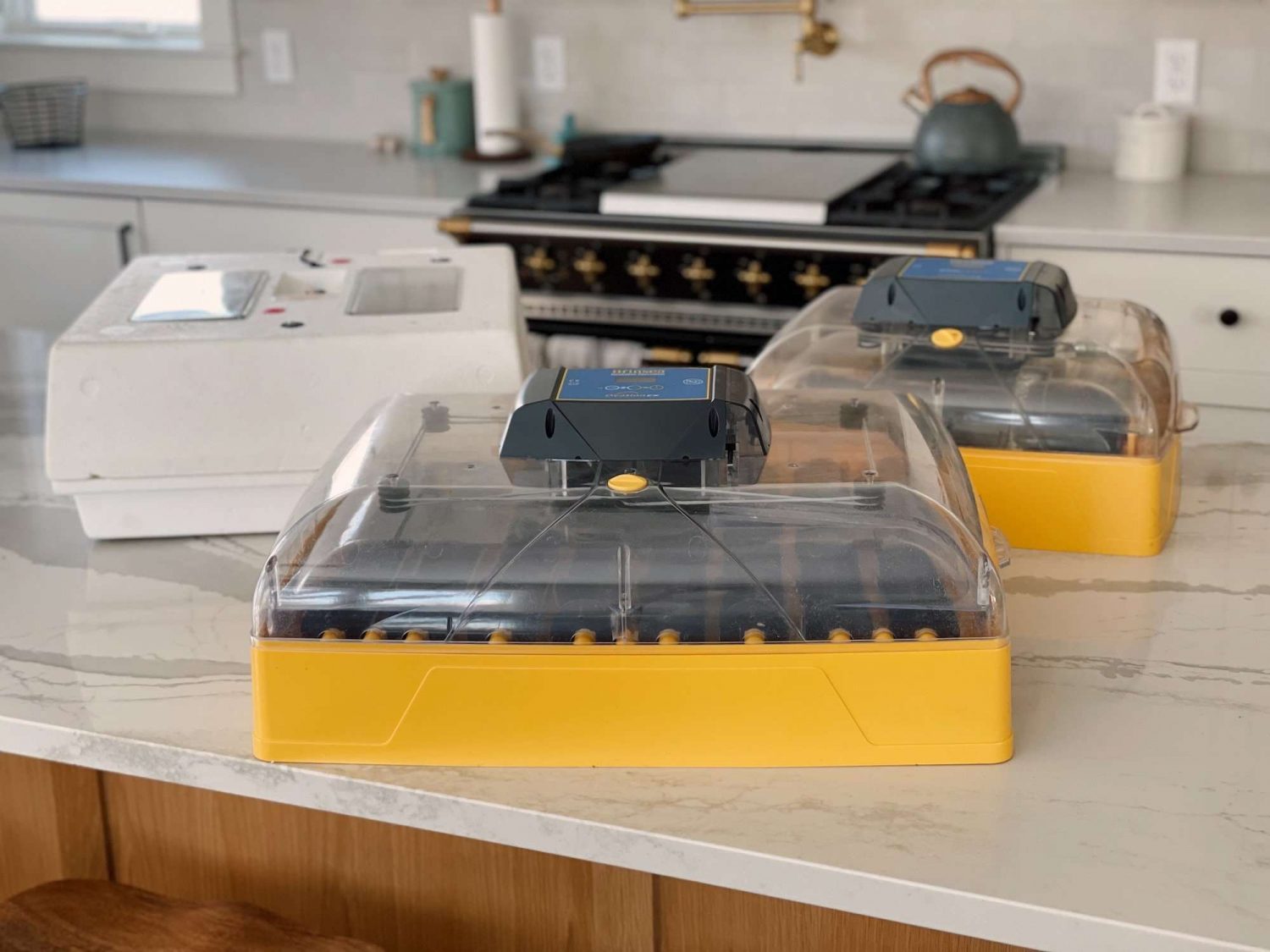
*Disclosure: This post may contain affiliate links to products (including Amazon). I’ll earn a small commission if you make a purchase through my link, at no additional cost to you! Regardless, I only link to products that I personally use on our homestead or believe in.
Table of Contents
Key Features of the Best Egg Incubators
Incubators come in a wide variety of options as far as size, style, features and price are concerned. It can be overwhelming just searching through them all. Let’s chat about the key features that I look for when shopping for the best egg incubators on the market.

Airflow
All incubators should have vents for air exchange (developing eggs are living and breathing!), but there are 2 types of airflow methods that are important to pay attention to: still-air and forced-air.
- Still-Air Incubator: This is the most basic form that you’ll find in cheap incubators. It relies on simple gravity to naturally circulate the air with a concept similar to a still room with no vents. This often produces hot and cold spots throughout the incubator, resulting in a poor hatch with some chicks hatching early, and some hatching late.
- Forced-Air Incubator: This type of incubator has a built-in fan to evenly distribute the warm, humid air. This results in all of your eggs developing similarly and often, a better overall hatch. Splurging for forced-air is worth every penny in my opinion.
Automated Temperature
This is absolutely critical. Just a 1 degree difference can impact your hatch.
- If it runs 1 degree high, you’ll have an early hatch with chicks prone to splayed legs and trouble walking.
- If it runs 1 degree low, you’ll have a late hatch with chicks prone to crooked toes, thin legs and unhealed navels.
Therefore, it’s helpful to have an incubator that automatically adjusts throughout the day to keep things stable. Such peace of mind! If your incubator has a manual turn dial for temperature and your room temperature goes up… your incubator temperature will also go up.
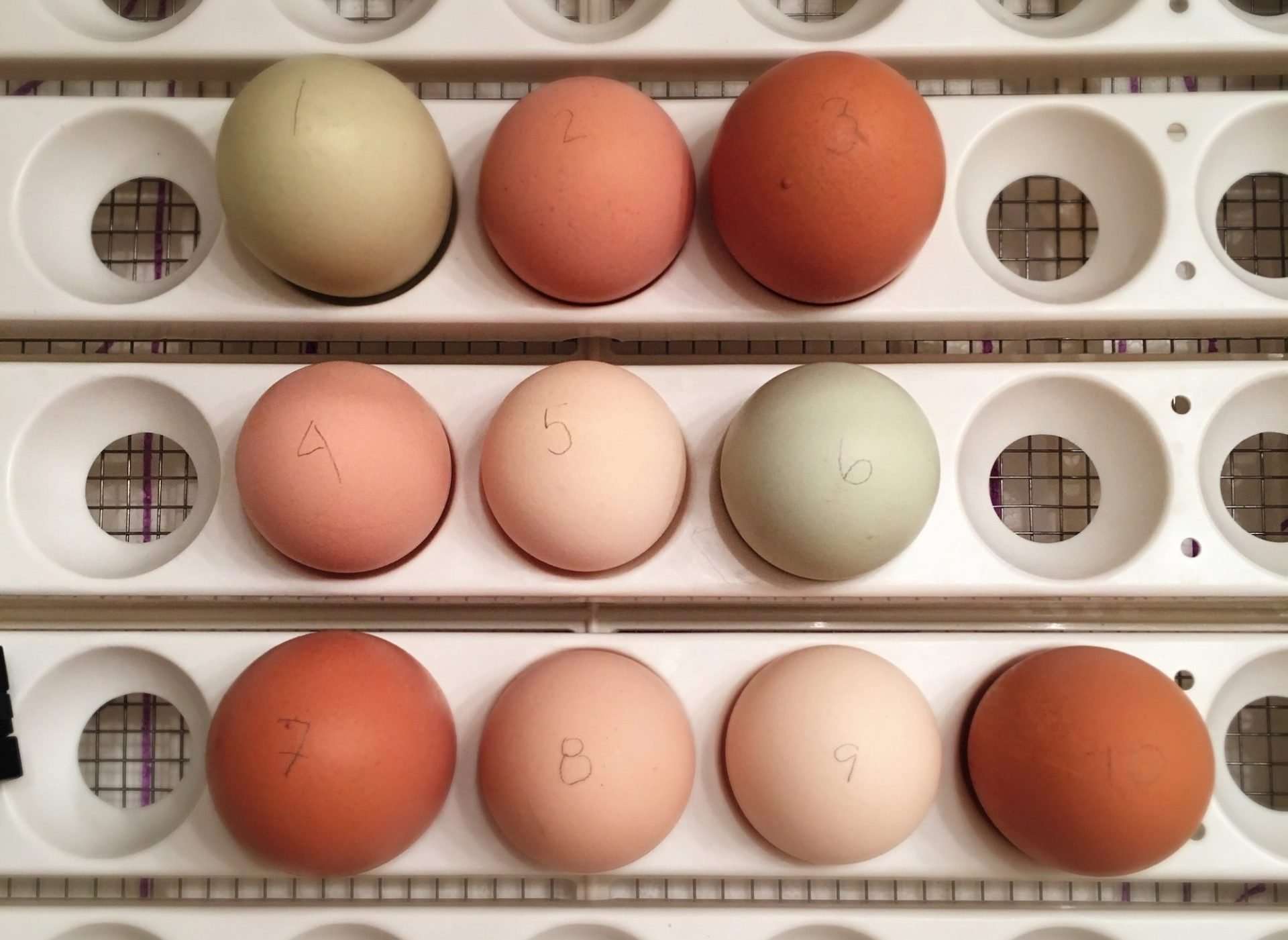
Tip #1: Verify that your incubator is forced-air or still-air. Forced-air incubators require a temperature of 99.5 degrees where still-air incubators require 102 degrees, however this is a general guideline and I would follow the instructions in your operating manual.
Tip #2: Make sure that you have several additional thermometers placed in your incubator (placed at the height of the top of the eggs) to confirm that your built-in thermometer is reading true. I like to use probe thermometers and poke them through a vent hole. It is common for cheap incubators to run hot or cold. I’ve definitely had my own share of hatch losses due to incorrectly calibrated thermometers!
Humidity Control
Humidity is one of the hardest things to get right, in my opinion. A lot of smaller egg incubators rely on manual addition of water to channels built into the bottom of the incubator. Not only is this easy to forget about and makes travel impossible, but it’s not very adjustable either. Plus, in most models, you need to open the incubator to make adjustments, which is not ideal during the hatch.
If you can find an incubator that automatically draws in and adjusts humidity based on your settings, it’s worth the extra cost. I’ve even gone on international vacations while my automatic incubators were running and could relax knowing they were taking care of it all for me 🙂
Thankfully, the success of the hatch weighs more heavily on overall humidity throughout the hatch and spikes aren’t as big of a deal. However, is important to get it right because:
- If humidity runs too high, then the egg doesn’t lose enough moisture resulting in large chicks that can drown at hatching time.
- If humidity runs too low, then the egg loses too much moisture resulting in “shrink-wrapped” chicks that fail to hatch.
I’ve found my hatch successes to vary even by adjusting the humidity by 3-5%! You’d never be able to achieve that precision with manual adjustments. To verify that your humidity setting is correct, I highly recommend buying TWO of these hygrometers (only $5!). The cheaper incubators are notorious for having poorly calibrated digital displays, so using these will make sure you’re on track.
Digital Display
This is a slick option so you can easily adjust the settings and quickly check the status of your incubator at any time. Most egg incubators today come with a digital display.
Egg Turner
In nature, a mother hen will periodically adjust her eggs and rotate them throughout the day. When incubating, this practice needs to be mimicked as much as possible because rotating allows the yolk to remain centered in the middle of the egg vs sticking to the side.
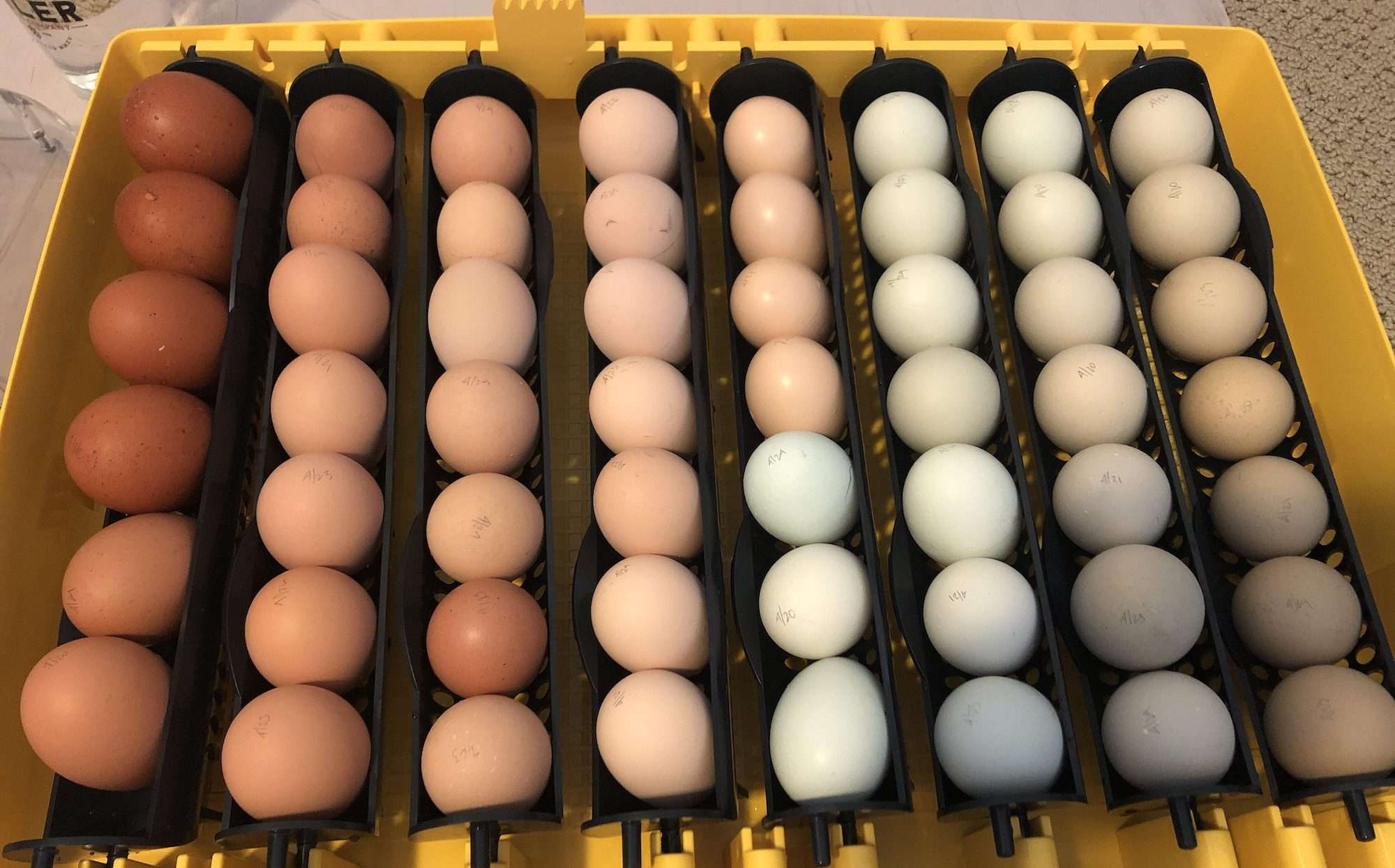
Chicken eggs need to be rotated from side-to-side a minimum of 3 times per day, every single day, for the first 18 days of the 21 day incubation period.
If this seems like too much for you, definitely invest in an incubator that has an automatic turner. I like this option because it means less opening of the incubator (resulting in temperature and humidity fluctuations), plus reduces the risk of accidental egg trauma.
Alarm
Some egg incubators feature an alarm that goes off anytime the temperature goes above or below your predetermined “safe zone.” This can alert you to intervene before things go south.
Capacity
There is no one right answer to this question; it all comes down to what is best for you. Incubators can be as small as holding just 5 eggs or they can hold hundreds!
Think about your goals and how many chicks you realistically want to hatch:
- If you live in the city and can only have 5 hens, go for a small size. Keep in mind that roughly 50% will end up being roosters; plus, your hatch rate will likely be 50-80%. Therefore, if you want to end up with 5 hens, I’d plan to incubate 20 eggs to be safe.
- If you live in the country and/or are thinking about routinely hatching chicks to sell them to your community as a side hobby, definitely go big! I started with a 28 egg incubator and rapidly outgrew that size.
My rule of thumb is to always go bigger than you think you need. Hatching is highly addicting and you’ll be expanding before you know it!
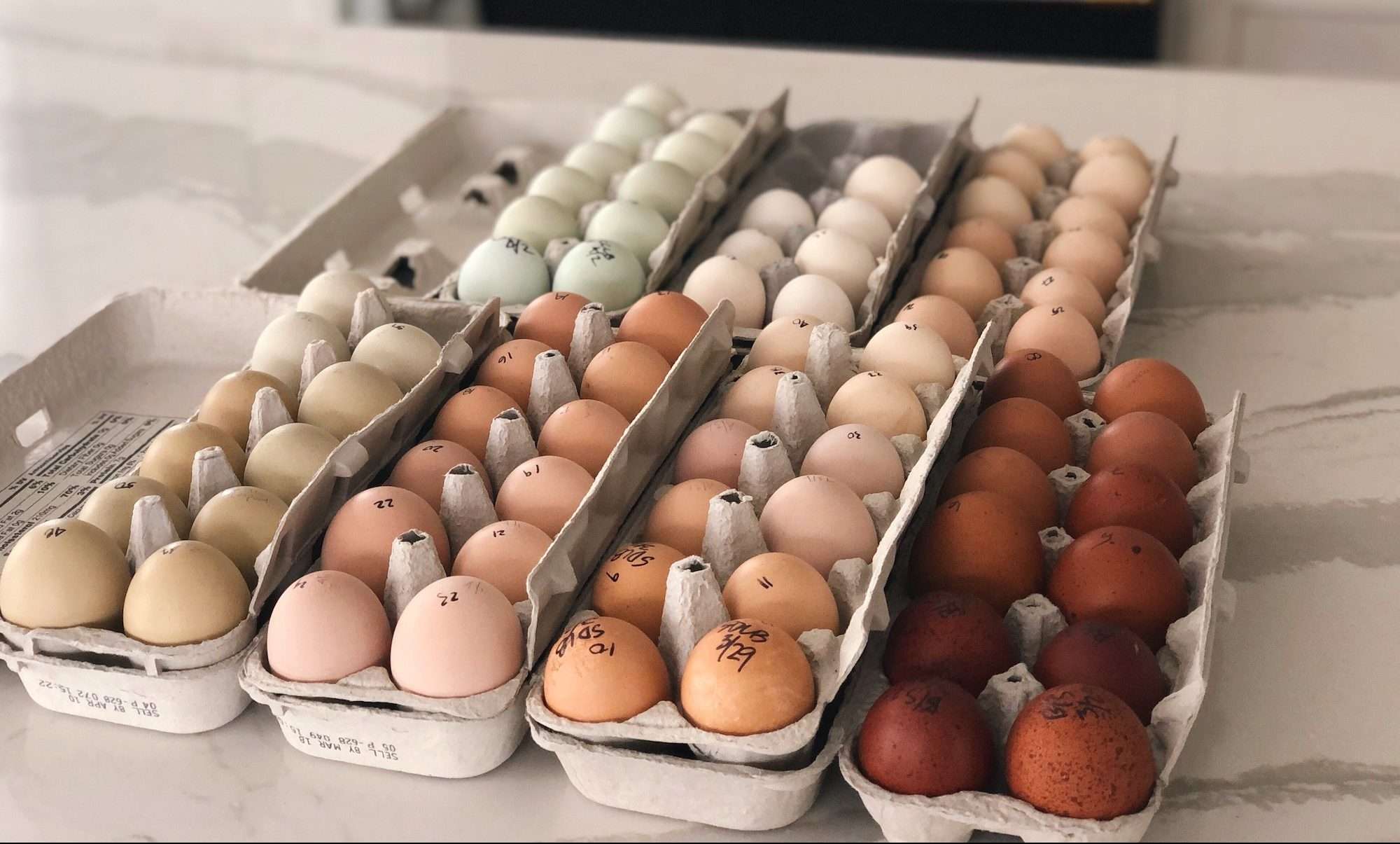
Ease of Cleaning
This is super important because hatching is messy and ensuring sanitary conditions for the next round is critical for its success. If your incubator doesn’t come apart easily, or if it is made of styrofoam (notorious for being hard to clean), then you’ll have trouble with this. Plastic is the best choice.
Viewing Window
This is not absolutely necessary, but it makes hatching so much more fun! When hatching starts, you’ll often find me with a chair pulled up and my nose pressed to the glass watching all of my new chicks hatch!
8 Best Egg Incubators in 2024
Now that you know what to look for, let’s get into some of the best egg incubators on the market! If you’re willing to purchase an incubator through my links below (at no additional cost to you!), I’ll make a small profit, which allows me to keep sharing content with you awesome people. Thank you!
8 Best Egg Incubators in 2024
Want more details about each of these incubators? No problem; I’ve got you covered!
#1 Brinsea Mini II EX
If your goal is to have a small backyard flock, look no further! Brinsea is my absolute favorite brand of incubator. All of their products are high quality, reliable, easy to clean and come with a 3 year warranty (as long as you register your product).
The Brinsea Mini II EX holds 7 eggs, so this is a great place to start. Brinsea has 3 lines for each incubator: Eco, Adv & EX. While the EX line is more expensive, it has fully automatic humidity control and is worth every penny in my opinion. I’ve gone on vacation with mine running and didn’t have to stress one bit!
#2 Brinsea Mini II Advance
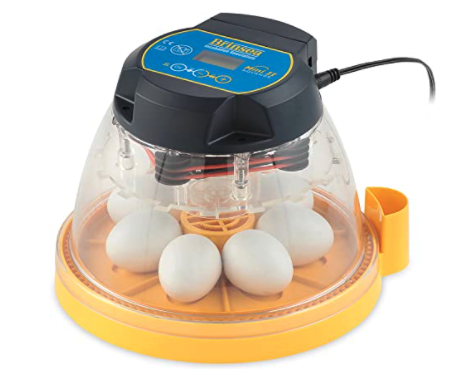
While my favorite Brinsea incubator is the EX line, I know that not everyone wants to shell out hundreds of dollars on an incubator. Therefore, the Mini II Advance is another excellent option from this same dependable company. The reduction in price comes from the manual humidity control compared to the Mini II EX.
It still has automatic temperature control, an egg turner, a great viewing window and it’s easy to clean. You can even adjust the intervals that your eggs are turned from 15 to 180 minutes. This is a best-of-both-worlds option!
TIP: If you have plans to hatch duck eggs, look for a larger incubator. This one is a bit too small for ducklings.
#3 KEBONNIXS 12 Egg Incubator
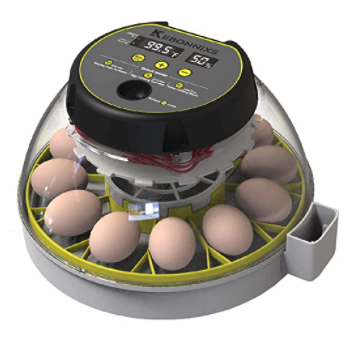
Fertile eggs are often sold by the dozen, so the fact that this incubator holds 12 eggs is great! It has a digital display of humidity and temperature, however, I highly recommend verifying their accuracy by adding your own thermometer and hygrometer. While this model requires you to manually add water to control the humidity, it is nice that you can add water externally. No need to open the lid!
This model also features a built-in egg candler so you can watch your baby chicks develop. Plus, the egg turner automatically stops 3 days before the hatch so that you don’t have to remember to turn it off.
TIP: The flooring is slick and can result in the chicks slipping and injuring their legs, so consider adding a layer of traction material to the bottom.
#4 Brinsea Ovation 28 EX
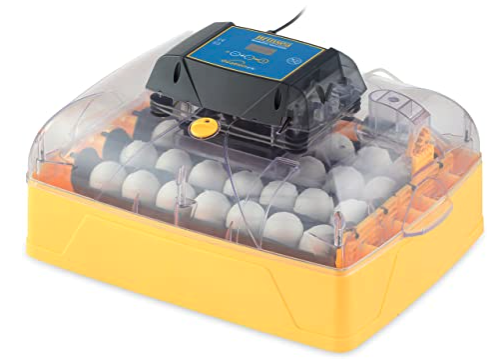
The Brinsea Ovation 28 EX is my absolute favorite incubator. Hands down. I’ve been debating buying a second one just because I love it so much. It really is the perfect size and I’ve had excellent hatches every single time.
It is fully automatic so it’s a true “set it and forget it” kind of incubator. I’ve gone on international vacations with this thing running and I didn’t have to worry about it at all! All of the pieces come apart for easy cleaning and it has a big viewing window to watch the hatch.
The best part of this incubator is how accurate and precise it is. I’ve thrown multiple thermometers and hygrometers in there to cross-check and this incubator is calibrated perfectly. I love that I don’t have to fuss with it or worry that something is off.
TIP: Don’t feel like you need to buy fancy replacement humidity sponges from the supplier. I just cut up basic $2 kitchen sponges that I find at the grocery store and it works great!
#5 Manna Pro Nurture Right 360 Incubator
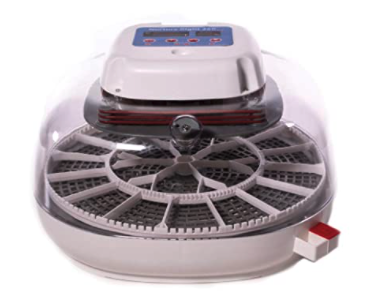
The Manna Pro Nurture Right 360 Incubator is a great budget pick if you want to hatch a decent number of eggs (it fits 22). It is fully automatic, with the exception of humidity control. You’ll need to manually add water yourself to keep it consistent. A nice feature is that it has a 21 day countdown and automatically stops turning the eggs 3 days before the hatch.
Based on the reviews, the negatives are that the turner tends to struggle to turn heavier eggs and it beeps loudly when the turner engages. The built-in egg candler is also pretty weak. Lastly, this incubator can be more challenging to clean.
TIP: Be careful when removing the lid. It can be easy for eggs or chicks to fall out because there is no lip on the edges.
#6 IncuView All-In-One Automatic Egg Incubator
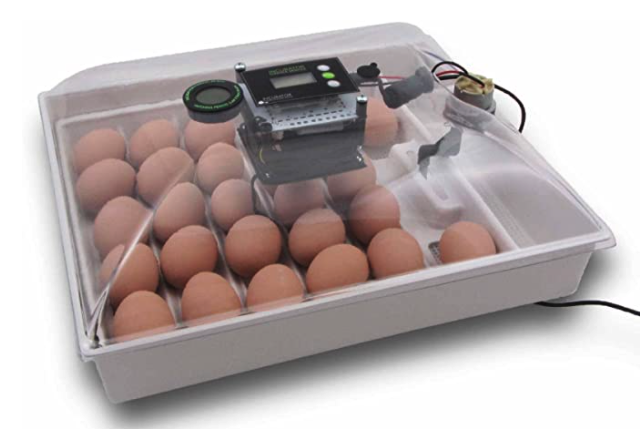
This incubator provides an incredible hatching experience with its large viewing window. You won’t miss a thing!
While it doesn’t feature automatic humidity control like the Brinsea models, it does provide digital display of humidity. Based on the reviews, the humidity levels do seem to fluctuate widely and need daily tweaking to hit your goal. As I’ve mentioned before, don’t trust that number alone! Always add an extra hygrometer or two to make sure it’s properly calibrated.
#7 Brinsea Ovation 56 EX
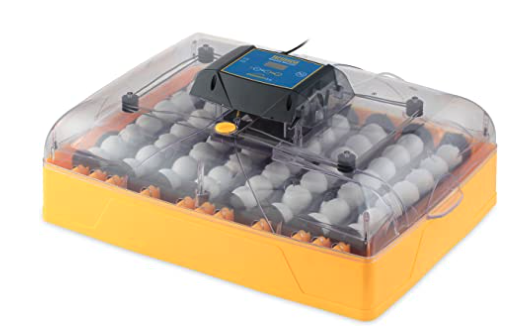
This is the big brother to my favorite incubator the Brinsea Ovation 28 EX. It’s also fully automatic, but twice as big. If you’re really wanting to hatch lots of chicks, this is an excellent option if you have the space.
It is fully automatic so it’s a true “set it and forget it” kind of incubator. I’ve gone on international vacations with this thing running and I didn’t have to worry about it at all! All of the pieces come apart for easy cleaning and it has a big viewing window to watch the hatch.
The best part of this incubator is how accurate and precise it is. I’ve thrown multiple thermometers and hygrometers in there to cross-check and this incubator is calibrated perfectly. I love that I don’t have to fuss with it or worry that something is off.
TIP: Don’t feel like you need to buy fancy replacement humidity sponges from the supplier. I just cut up basic $2 kitchen sponges that I find at the grocery store and it works great!
#8 HovaBator Genesis 1588
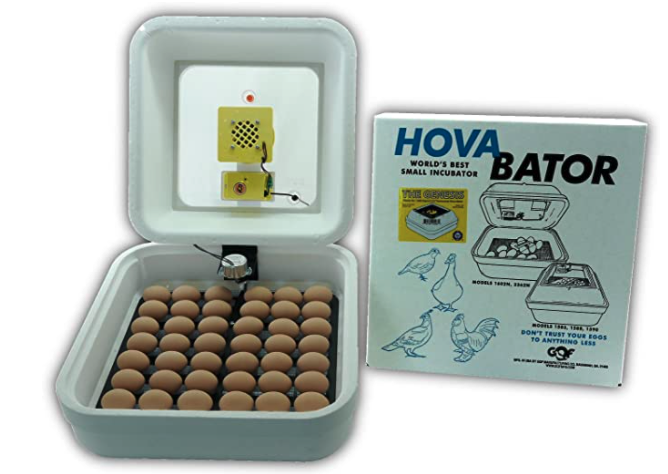
This wouldn’t be a complete incubator list without the classic foam incubator. While I have a love-hate relationship with them, this is often where most of us begin our incubating journey! They can be finicky and definitely require multiple thermometers and hygrometers, but this is an inexpensive way to hatch a lot of eggs.
TIP: I highly recommend placing a minimum of TWO hygrometers and TWO external thermometers (reading at a height at the top of the eggs) to verify that everything is running as it should.
While there are a lot of foam incubators out there that look similar to the HovaBator Genesis 1588 (and are a bit cheaper), don’t get swayed by the other options. I know you saw that $50 one at Tractor Supply… don’t do it! Many of them are junk and there’s nothing more heartbreaking than losing an entire hatch. I spent some time digging into each one and this one really seems to be the best budget-friendly pick out of them all.
Other Articles You’ll Love:
- Hatching Chicken Eggs: The Ultimate Beginner’s Guide
- Candling Chicken Eggs: Day-By-Day Development
- Brooding in Poultry: Everything You Need to Know!
- How to Care for Chickens: A Beginner’s Guide
Summary
That was fun! I hope you found this helpful in picking the perfect incubator for you and your homestead. As you can see, egg incubators come in many different styles, features and price points and we only covered 7 of them! It’s a small investment, so definitely spend some time reflecting on my 8 best egg incubators table to really feel out which one seems like the right fit. You can’t go wrong with any of them, really!
Once your incubator arrives, read the instruction manual and let it run for a minimum of 24 hours. After 24 hours, make sure to double-check its accuracy by inserting additional thermometers and hygrometers. If your digital reading is off, adjust your settings as needed.
Are you curious how to actually go about incubating eggs? This article by Backyard Chickens is the exact one that I learned from years ago. Then, once your chicks hatch, you’ll definitely want to check out my best tips for Brooding in Poultry.
If you liked this article, you’ll definitely want to read my article Cooking a Rooster: The Basics for when you end up with extra roosters after hatching! It’s wonderful to keep a couple good roosters around, but keeping more than your flock can handle can lead to fights and stress on your hens.
Happy hatching! 🙂
